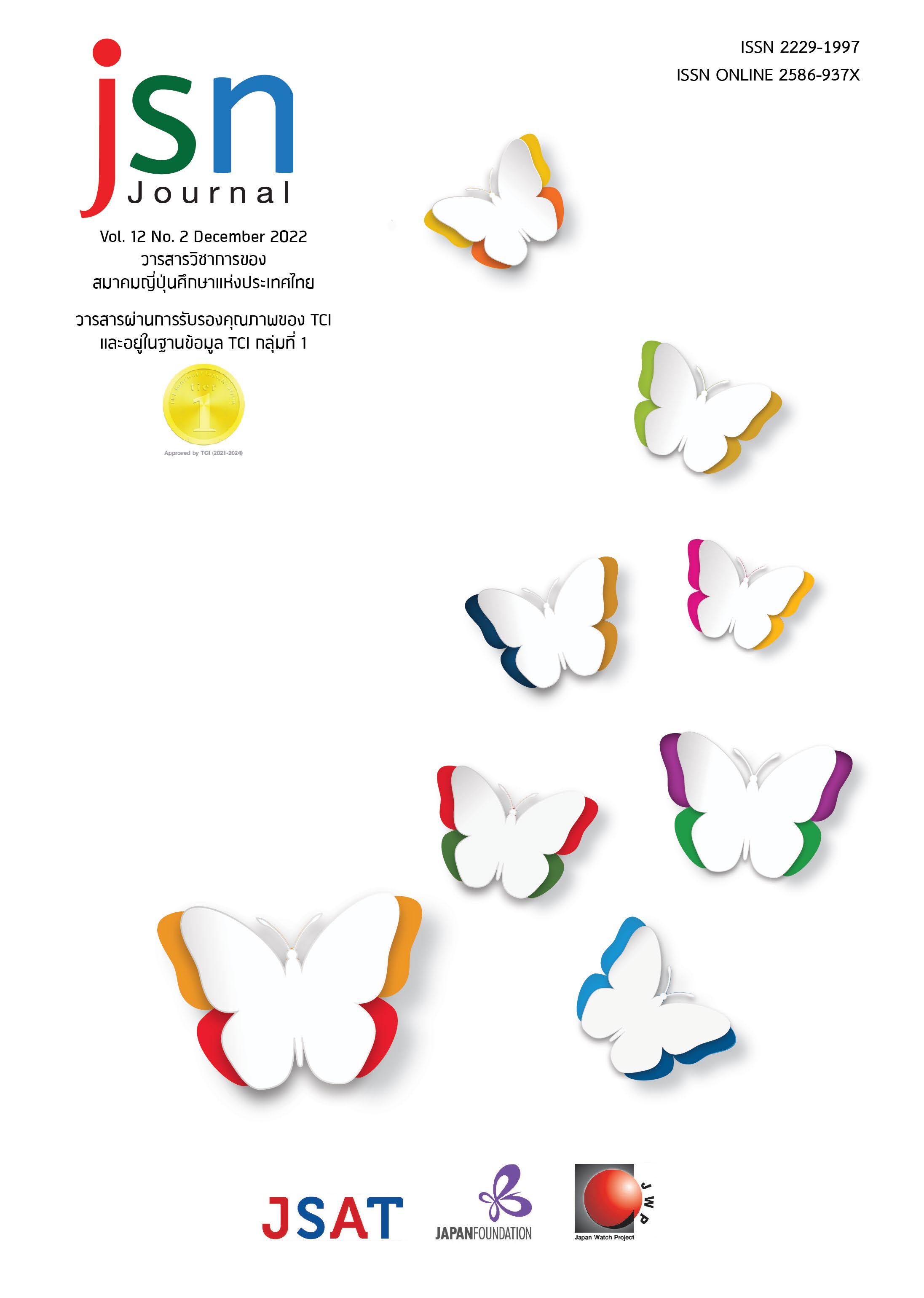Viewpoint Expressions Used in Narrative Structure A Case Study of Japanese Native Speakers and Thai Learners’ Story Writing
Main Article Content
Abstract
The purpose of this study is 1) to investigate the use of viewpoint expressions as well as viewpoint maintenance and subject coherence in the structure of story writing and in the relation between sentences; and 2) to compare the use of expressions between Japanese native speakers (JJJ) and Thai learners (TTH). Regarding the analysis, the data from JJJ and TTH in a story writing task were collected from the International Corpus of Japanese as a Second Language. The result of the observation of the JJJ’s data reveals that in 承, JJJ tend to shift the subject of the sentence from the main character to a new one without using any viewpoint expressions, and otherwise use the benefactive expression “~てくれる.” On the other hand, in 転, the JJJ narrate the story from the main character’s viewpoint and maintain the main character as the subject of every sentence. As for TTH, the group tends to use the same types of viewpoint expressions in both structures as JJJ do, however with smaller numbers. Based on the observed use mentioned, it is expected that Japanese instructors might be able to design teaching methods for narrative writing education so that Thai learners could use viewpoint expressions more correctly and as a result, communicate more efficiently.
Article Details

This work is licensed under a Creative Commons Attribution-NonCommercial-NoDerivatives 4.0 International License.
ข้อความและข้อคิดเห็นต่างๆ ในบทความเป็นของผู้เขียนบทความนั้นๆ ไม่ใช่ความเห็นของกองบรรณาธิการหรือของวารสาร jsn Journal
References
สรณัฐ ไตลังคะ. (2560). ศาสตร์และศิลป์แห่งการเล่าเรื่อง (พิมพ์ครั้งที่ 3 ฉบับปรับปรุง). โครงการเผยแพร่ผลงานทางวิชาการ คณะมนุษยศาสตร์ มหาวิทยาลัยเกษตรศาสตร์.
เอทสึโกะ โทโมมัทสึ, ซาชิ ฟุกุชิมะ และคาโอริ นากามุระ. (2559). 新完全マスター文法 日本語能力試験N2 [Go JLPT N2 ไวยากรณ์] (เมธี ธรรมพิภพ, ผู้แปล). สำนักพิมพ์ภาษาและวัฒนธรรม.
市川孝. (1978).『国語教育のための文章論概説』教育出版.
奥秋義信. (1993).『日本語の文章術-文章の書き方百科 小論文からビジネス文まで』創拓社.
迫田久美子・小西円・佐々木藍子・須賀和香子・細井陽子. (2016).「多言語母語の日本語学習者横断コーパス」『国語研プロジェクトレビュー』6-3 : 93-110.
ダンタイ クインチー. (2020). 「中級日本語学習者の視点は母語によって異なるか:I-JASのストーリーテリングのデータの分析から」『国立国語研究所論集』18 : 93-119.
中浜優子・栗原由華. (2006). 「日本語の物語構築:視点を判断する構文的手がかりの再考」『言語文化論集』27(2) : 97-107.
森田良行. (1995).『日本語の視点~ことばを創る日本人の発想~』作拓社.
ラルアイソング タナパット. (2014). 「タイ人日本語学習者と日本語母語話者の視座の置き方に関する分析―10コマ漫画の描写に見られる視点表現を中心に―」『筑波大学地域研究』35 : 147-162.
渡辺文生. (2012).「日本語の語りの文章における視点の表現とその指導について」『山形大学大学院社会文化システム研究科紀要』9 : 51-58.
แหล่งที่มาข้อมูล
多言語母語の日本語学習者横断コーパス(I-JAS) (国立国語研究所)http://lsaj.ninjal.ac.jp สืบค้นข้อมูล 15 กรกฎาคม 2565

